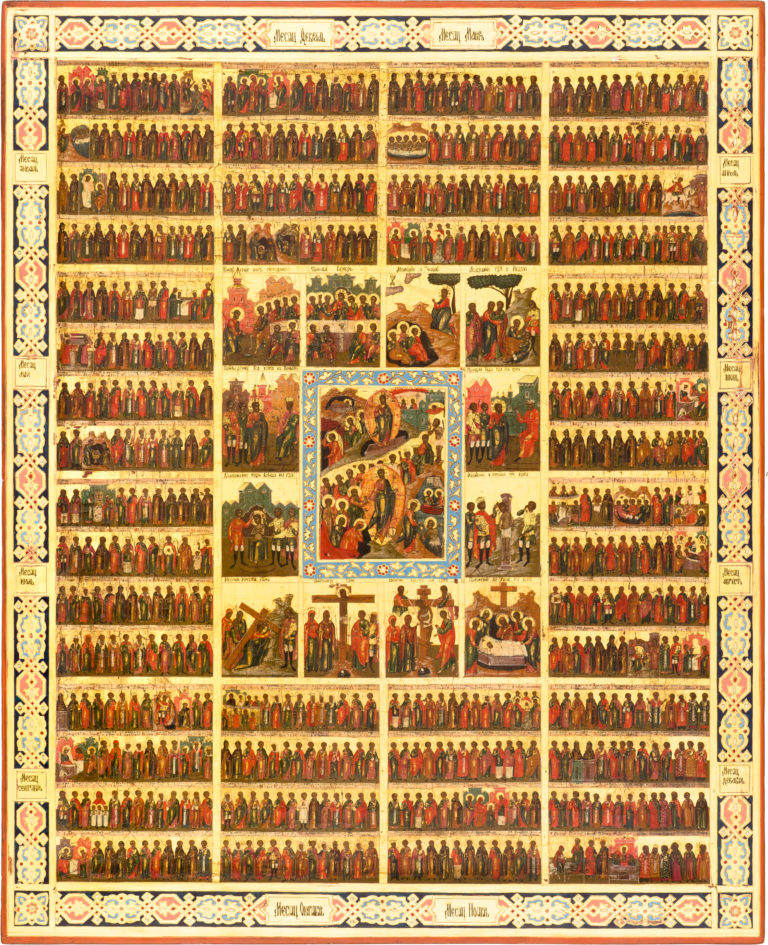The Resurrection—the Descent into Hell, with the Yearly Menaion and the Passion Cycle
Icon: last quarter of the 19th century.
Icon painting villages of the Vladimir region (Kholuy?)
Size: 71 х 58 х 4 cm
Wood, two incut supporting bars, absence of an incut centerpiece, underlying layer of canvas (?), gesso, tempera.
The authentic paint layer is covered with craquelure; restoration work and replaced fragments visible; the gold layer on the background and borders has been partially replaced.
Contact us

The Resurrection—the Descent into Hell, with the Yearly Menaion and the Passion Cycle
Diagram of the border scenes:
The Festive cycle:
- January Menaion;
- February Menaion;
- March Menaion;
- April Menaion;
- May Menaion;
- June Menaion;
- July Menaion;
- August Menaion;
- September Menaion;
- October Menaion;
- November Menaion;
- December Menaion.
The Passion Cycle:
- The Washing of the Feet;
- The Last Supper;
- The Prayer in Gethsemane;
- Judas’ Betrayal;
- Christ before Pilate;
- Christ before Caiaphas;
- The Crown of Thorns;
- The Flagellation of Christ;
- The Carrying of the Cross;
- The Crucifixion;
- The Taking Down from the Cross;
- The Entombment of Christ.
The icon encompasses the Yearly Menaion and the main feast of the liturgical year, the Ressurection — the Harrowing of Hades, surrounded by scenes of Christ’s passions. Suchicons, due to their universality, were incredibly popular in the 18th — early 20th centuries. The Yearly Menaion (monthly calendar of saints and feasts) follows the regular, secular calendar — from January to December. Saints are depicted in order of their feast day (with usually a single saint, rarely two or three, selected for each day). The immovable feasts (those that have fixed dates and are not part of the Easter cycle) are also depicted in their respective months. These include the Theophany, the Synaxis of John the Baptist, Candlemas, the First and Second Uncovering of John the Baptist, the Annunciation, the Synaxis of the Archangel Gabriel, the Nativity of John the Baptist, the Feast of the Wood of the Holy Cross, the Transfiguration, the Dormition of the Mother of God, the Exaltation of the Holy Cross, the Beheading of John the Baptist, The Miracle in Honech, the Nativity of the Mother of God, the Elevation of the Holy Cross, the Conception of John the Baptist, the Feast of the protective veil of the Mother of God (Pokrov), the Synaxis of the Archangel Michael, the Entrance of the Mother of God into the Temple, and the Synaxis of the Mother of God.
The moveable feasts depend on the day of Easter (the Feast of the Resurrection of Christ), symbolically paving the way and continuing the celebration of “The Feast of Feasts” (Pascha). The cycle of moveable feasts became known as the Triodion, since this is the time when the Triodion (Greek — τρία — “three”, ᾠδή, ᾠδά — “song”) is chanted, a chant that consists of three-song canons. The Holy Week, dedicated to the commemoration of the last days of Christ’s life before His Crucifixion, is part of the Lenten Triodion. The Passion Cycle on the icon consists of 12 border scenes; it starts with “The Washing of the Feet” and The Last Supper, and includes the scenes of Judas’ betrayal, the judgement of Christ and His flagellation. The culmination of the Passion Cycle is the Crucifixion; that is why this scene, along with “The Taking Down from the Cross” is placed on a single axis, along with the Resurrection of Christ. The cycle ends with the “Entombment of Christ”.
The traditional style of the icon, the somewhat schematic manner of painting, the subtle color scheme — are all highly evocative of late 19th century iconography. The icon was clearly created in one of the iconographic village centers of the Vladimir region, whose masters were known for this line of work. The notable ornamentation on the borders (evocative of the Russian architects’ and artists infatuation with 17th century wooden architecture — which was a dominant trait in the 1860s, is traditionally tied to the iconographers of the Kholuy Village. The Resurrection — the Harrowing of Hades scene is separated from the border scenes by a separate, narrow frame with floral ornamentation.